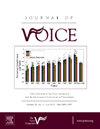三级耳鼻喉科医生对歌唱嗓音的关注。
IF 2.5
4区 医学
Q1 AUDIOLOGY & SPEECH-LANGUAGE PATHOLOGY
引用次数: 0
摘要
目的确定因一般嗓音不适到嗓音门诊就诊时将歌唱嗓音视为主要问题的患者的患病率和特征:方法:从病历中收集有关人口统计学、病史、喉镜检查、诊断和后续治疗的数据,以及自我报告问卷,包括嗓音障碍指数-10(VHI-10)和临床嗓音问卷:结果:在因一般嗓音问题前往嗓音门诊就诊并填写了 VHI-10 的患者中,共有 17% 的人认为唱歌嗓音是主要问题。与参照组相比,关注歌唱嗓音问题的患者在 VHI-10 的多个问题上表现出更大的障碍,尤其是在对个人和社会生活的影响、收入损失、发声清晰度的不可预测性、主观烦恼和主观障碍方面。关注歌唱嗓音的人也更关注自己的嗓音问题,尽管在分类诊断方面没有统计学差异,但他们更有可能被推荐接受嗓音治疗,也更有可能参与嗓音治疗:考虑到专业歌手和业余歌手,研究对象中有 17% 的人存在嗓音问题。有歌唱嗓音问题的患者主要是业余歌手,文献中对他们的描述仍然很少。我们强调,必须对这部分患者的需求保持敏感并作出反应。本文章由计算机程序翻译,如有差异,请以英文原文为准。
Singing Voice Concern in Tertiary Laryngology Practice
Objectives
To determine the prevalence and characteristics of patients who identify singing voice as a primary concern when presenting with general voice complaints to a voice clinic.
Methods
Data were collected from medical records on demographics, medical history, laryngoscopy exam, diagnosis, and subsequent treatments; and from self-report questionnaires including the Voice Handicap Index-10 (VHI-10) and clinical voice questionnaire.
Results
A total of 17% of patients presenting to a voice clinic with general voice problems who completed a VHI-10 identified singing voice as a primary concern. Compared to the reference cohort, patients concerned about singing voice report greater handicap on several questions of the VHI-10, particularly in personal and social life impact, loss of income, unpredictability of vocal clarity, subjective upset, and subjective handicap. Those concerned with singing voice were also more concerned about their vocal problem, and both more likely to be recommended voice therapy and participate in voice therapy despite no statistical differences in categorical diagnoses.
Conclusions
When considering both professional and recreational singers, voice concerns occurred in 17% of the cohort under study. Patients with singing voice concerns are accounted for largely by recreational singers, who remain poorly characterized in the literature. We underscore the importance of sensitivity and responsivity to the needs of this group of patients.
求助全文
通过发布文献求助,成功后即可免费获取论文全文。
去求助
来源期刊

Journal of Voice
医学-耳鼻喉科学
CiteScore
4.00
自引率
13.60%
发文量
395
审稿时长
59 days
期刊介绍:
The Journal of Voice is widely regarded as the world''s premiere journal for voice medicine and research. This peer-reviewed publication is listed in Index Medicus and is indexed by the Institute for Scientific Information. The journal contains articles written by experts throughout the world on all topics in voice sciences, voice medicine and surgery, and speech-language pathologists'' management of voice-related problems. The journal includes clinical articles, clinical research, and laboratory research. Members of the Foundation receive the journal as a benefit of membership.
 求助内容:
求助内容: 应助结果提醒方式:
应助结果提醒方式:


